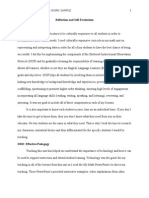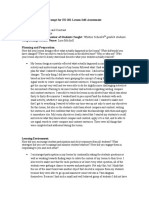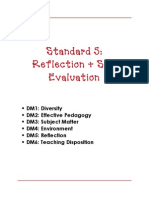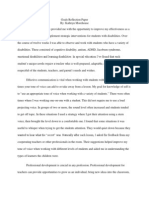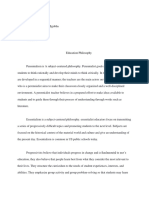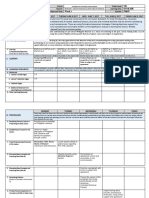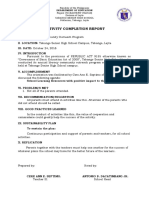Edts 234 Journal 2
Edts 234 Journal 2
Uploaded by
api-314845964Copyright:
Available Formats
Edts 234 Journal 2
Edts 234 Journal 2
Uploaded by
api-314845964Original Title
Copyright
Available Formats
Share this document
Did you find this document useful?
Is this content inappropriate?
Copyright:
Available Formats
Edts 234 Journal 2
Edts 234 Journal 2
Uploaded by
api-314845964Copyright:
Available Formats
EDTS 234
Mentor Group
Liz Lobert
Journal #2 February 4, 2016
Retell
My first introduction to my mentor teacher and her methods of teaching was amazing.
She teaches two grade seven classes math and science on Tuesday mornings; it is the same
curriculum done twice in a row. Both classes were in the late stages of a unit on adding and
subtracting integers in math, and a project to design and build a thermos that will be effective in
keeping a hot liquid at a constant temperature.
The instruction on integers was done through a list of projects worth different amounts of
points. The students chose the projects they wanted to do and the point for those projects had to
add up to at least one hundred. For most students this would mean a total of at least four projects
of their choice. Fifteen minutes of class time was used to do a group activity called
Showdown. Word problems were presented via Google Classroom on Chromebooks to each
table. The students worked separately to answer the word problem and then looked at the work of
everyone else at the table. The table negotiated among themselves to figure out what the right
answer was.
MH used indirect teaching methods about eighty percent of the time. She did
direct teaching about twenty percent of the time. The largest amount of time was spent working
on projects that most of the students were really interested in. By using indirect methods, MH
made sure that the majority of the students learning was transactional, as the students worked
together to determine right answers, and transformative, as the students built their own
understanding of integers through the four projects they chose from their lists.
Reflect
My first day with MH was almost the opposite of my experience in my first practicum. It
was exciting to see students working, negotiating, and discussing the classwork. Some of the
students worked on their own, and some were in groups. There was structure in the form of
expected outcomes, but not in the ways learning happened.
My mentor teacher, MH, used several instructional intelligence strategies in her class. I
saw the students do Stand up, hand up, pair up, and Think, Pair, Share. The
EDTS 234
Mentor Group
Liz Lobert
Showdown activity was done instead of a worksheet to help the students apply what they have
been learning about adding and subtracting integers in real life situations. She also used the
group activity to promote her hidden curriculum; she is trying to teach her students good social
skills. MH moved between groups as they did their showdowns to assess for understanding. On
two occasions, she stopped the groups and went over the word problems she found most people
had problems with.
Assessment was ongoing as the teacher moved around the classroom and monitored the
work, as well as through the game she had them play. A summative assessment was planned in
the form of a quiz on integers at the end of the week, but the students also had the option of
taking the mark from their integer projects instead. So even in the type of assessment they
received the students had some control. They didnt have to work hard on their integer projects
because the mark from the projects would only come into play if it was better than their mark on
the quiz. But if the students didnt do the projects, then they didnt put the effort into learning
that would allow them to do well on the quiz. The students were completely responsible for their
own learning and they knew it.
If I were to base my assessment of the effectiveness of this type of teaching on the
activity happening in the classroom, I would say the students in both classes had really taken
ownership of their own learning. I am interested in how the students did overall on the quiz, as
well as how many students did much better on the quiz versus their projects, or vice versa. I
know the teacher, who has been teaching since 2003, is confident in her methods, but I would
like to see evidence that the methods translate into knowledge the students can communicate to
others.
Self-Analysis
I am both pragmatic and skeptical in my philosophical views. This means that I need the
evidence of my own eyes to fully believe that what I am being taught works, but if I can see that
some method does work, even if it is contrary to what I previously believed, I will adopt it.
My first practicum was in a classroom much like the one I sat in many years ago as a
student. It seemed to be effective without being much different from what I had experienced as a
EDTS 234
Mentor Group
Liz Lobert
child. This made me wary of the progressive views condemning the type of teaching I was
observing in my practicum.
I am excited that my current practicum is with a teacher who has embraced the methods
of constructivism and inquiry based learning because I can see what I have learned in theory
being played out in a real classroom with less than model students. For me, a theory is only as
good as the paper it is written on until I can see it in real life situations.
At this point I really have to consider: What are my driving goals as a teacher? My
mentor teacher felt that students need to learn social skills in order to find long term success so
she has purposefully included activities that will help achieve that goal in her students daily
schedule. If my goal is to help prepare students for the rigours of life after school I might
approach my lesson planning differently than if my goal is to help students stay in school until
they graduate. How can I best serve the students that are entrusted to my care? These are the
things that I need to consider as my teaching philosophy evolves with my increasing education
and experience in the classroom.
You might also like
- Episode 10-FS 1Document6 pagesEpisode 10-FS 1moniqueanntherese rasula83% (47)
- Candidate Informaton Form (ESE)Document2 pagesCandidate Informaton Form (ESE)Rama IssamAbufarhaNo ratings yet
- 3 - Teacher Interview Reflection PaperDocument5 pages3 - Teacher Interview Reflection Paperapi-30470463367% (3)
- Full Coaching Cycle Reflection PaperDocument8 pagesFull Coaching Cycle Reflection Paperapi-240190507No ratings yet
- Portfolio StandardsDocument17 pagesPortfolio Standardsapi-275437738100% (1)
- RONDALLADocument6 pagesRONDALLAAngelica Pataray Erjas100% (3)
- Intro To Teaching - Module 3Document4 pagesIntro To Teaching - Module 3api-236265531No ratings yet
- Integrated Reflection Spring 2013Document4 pagesIntegrated Reflection Spring 2013chadbobbitNo ratings yet
- Reflection and Self-EvaluationDocument5 pagesReflection and Self-Evaluationapi-241287310No ratings yet
- What Is A Coaching Conversation?Document15 pagesWhat Is A Coaching Conversation?HadusssNo ratings yet
- Annotated Bib 3Document7 pagesAnnotated Bib 3api-236106821No ratings yet
- Pip FindingsDocument7 pagesPip Findingsapi-433788836No ratings yet
- Teaching PhilosophyDocument8 pagesTeaching Philosophyapi-484515746No ratings yet
- School Experience Reflection Journal 2Document6 pagesSchool Experience Reflection Journal 2api-272317458No ratings yet
- Reflective Journal 5 EntriesDocument11 pagesReflective Journal 5 Entriesapi-703253998No ratings yet
- Educ 224 Reading Response 2Document2 pagesEduc 224 Reading Response 2api-378042907No ratings yet
- Edu221 Philosophy PaperDocument6 pagesEdu221 Philosophy Paperapi-535069797No ratings yet
- Observed Lesson Self-AssessmentDocument4 pagesObserved Lesson Self-Assessmentapi-305785129No ratings yet
- CoteachingDocument5 pagesCoteachingapi-300196677No ratings yet
- My ReflectionDocument6 pagesMy ReflectionJai Ejumpz JaidiNo ratings yet
- Final Creative ResponseDocument13 pagesFinal Creative Responseapi-315748663No ratings yet
- Mot ReflectionDocument2 pagesMot Reflectionapi-212237419No ratings yet
- Reflective LogsDocument6 pagesReflective LogsZil-E- Zahra - 41902/TCHR/BATDNo ratings yet
- Prpsem Weekly ReflectionsDocument5 pagesPrpsem Weekly Reflectionsapi-313392868No ratings yet
- MATC Synthesis PaperDocument10 pagesMATC Synthesis Paperemrubes93No ratings yet
- Signature Assignment My Best LessonDocument14 pagesSignature Assignment My Best Lessonapi-487546672No ratings yet
- Theories of Learning - Denicia PadgettDocument5 pagesTheories of Learning - Denicia PadgettKavitha AlwisNo ratings yet
- Educ 430 lt4Document8 pagesEduc 430 lt4api-590411764No ratings yet
- Standard 5 FinalDocument7 pagesStandard 5 Finalapi-252417954No ratings yet
- Metodologie in IngleseDocument2 pagesMetodologie in IngleselorenapizzutoNo ratings yet
- Psych FinalDocument6 pagesPsych Finalapi-245810041100% (1)
- Intasc Standard 1 Learner DevelopmentDocument7 pagesIntasc Standard 1 Learner Developmentapi-253456954No ratings yet
- Gearns Te857 Reflection 1Document10 pagesGearns Te857 Reflection 1api-554371929No ratings yet
- Presentation ReflectionDocument5 pagesPresentation Reflectionembry44No ratings yet
- Reflective EssaysDocument3 pagesReflective EssaysSujan AcharyaNo ratings yet
- Reflective Practice What Why and HowDocument7 pagesReflective Practice What Why and HowtracycwNo ratings yet
- Classroom Management Plan and ScriptDocument19 pagesClassroom Management Plan and Scriptapi-302270555No ratings yet
- Lab Reflection Paper 1Document5 pagesLab Reflection Paper 1api-583029542No ratings yet
- Gough Te807 FinalDocument5 pagesGough Te807 Finalapi-304892126No ratings yet
- Philosophy PaperDocument11 pagesPhilosophy Paperapi-363092081No ratings yet
- Week 1: ReflectionDocument27 pagesWeek 1: ReflectionIntan Nurbaizurra Mohd RosmiNo ratings yet
- Philosophy of EducationDocument7 pagesPhilosophy of Educationapi-263268375No ratings yet
- Post Conference Questions Observation 2Document3 pagesPost Conference Questions Observation 2api-636132170No ratings yet
- Student Teaching Reflection Katie MorehouseDocument5 pagesStudent Teaching Reflection Katie Morehouseapi-250709386No ratings yet
- No Such Thing As A Quick Fix: Creating My Own Answers For Classroom IssuesDocument9 pagesNo Such Thing As A Quick Fix: Creating My Own Answers For Classroom Issuesapi-511721497No ratings yet
- Episode 1. 1 Principles of Learning Final AnswerDocument6 pagesEpisode 1. 1 Principles of Learning Final AnswerFloramie LlamosNo ratings yet
- Pedagogical Sets: Set Test 1Document14 pagesPedagogical Sets: Set Test 1Abdul Rahim ChandioNo ratings yet
- Sub IIDocument8 pagesSub IIapi-405681780No ratings yet
- Edu 201 Philosophy GoodDocument5 pagesEdu 201 Philosophy Goodapi-550363606No ratings yet
- Field Study 6 - Episode 2Document7 pagesField Study 6 - Episode 2Anonymous ZcIiVjdTkNo ratings yet
- Ued496 Angela Tortora Artifact CDocument8 pagesUed496 Angela Tortora Artifact Capi-262598106No ratings yet
- Reaction Paper IN Sted 2: Inocencio, Donita Rose M. Bsed Iii - EnglishDocument7 pagesReaction Paper IN Sted 2: Inocencio, Donita Rose M. Bsed Iii - EnglishKeiKoNo ratings yet
- Bago Naman Na Paprint MamaDocument15 pagesBago Naman Na Paprint MamaCarl Jay GarciaNo ratings yet
- Field Experience 2Document4 pagesField Experience 2api-742943826No ratings yet
- SchoolDocument3 pagesSchoolreysiane5vestidasNo ratings yet
- Observation Reflection: January 23, yDocument3 pagesObservation Reflection: January 23, yVictor FloresNo ratings yet
- Teaching PlatformDocument8 pagesTeaching Platformapi-340158983No ratings yet
- Problem Based LearningDocument6 pagesProblem Based LearningGTA V GameNo ratings yet
- Action Research Project: How Does Cooperative Learning Affect Student Engagement During Group Work in Grade 3 and 4?Document42 pagesAction Research Project: How Does Cooperative Learning Affect Student Engagement During Group Work in Grade 3 and 4?api-243757744No ratings yet
- Humanizing Classroom Management: Restorative Practices and Universal Design for LearningFrom EverandHumanizing Classroom Management: Restorative Practices and Universal Design for LearningNo ratings yet
- Project-Based Learning Anywhere: Live It, Learn It, Love It!From EverandProject-Based Learning Anywhere: Live It, Learn It, Love It!No ratings yet
- Adapted Aquatics Lesson Plan Template 1Document5 pagesAdapted Aquatics Lesson Plan Template 1api-250231039No ratings yet
- Readiness Assessment Checklist ODL&BLDocument2 pagesReadiness Assessment Checklist ODL&BLShermain Valdez JacobNo ratings yet
- Daily Lesson Log Mil - Hcsedentario Sept 5-9-2016Document3 pagesDaily Lesson Log Mil - Hcsedentario Sept 5-9-2016Jessemar Solante Jaron Wao100% (1)
- Skeletal Presentation On Problem Based Learning... FINALDocument5 pagesSkeletal Presentation On Problem Based Learning... FINALPabhat KumarNo ratings yet
- Session 1-8 Development and Impact of SIM-MOD (Strategic Intervention MAterial and Module COmbined) On Students' Academic Achievement in Mathematics at The 8th Grade Leve PDFDocument70 pagesSession 1-8 Development and Impact of SIM-MOD (Strategic Intervention MAterial and Module COmbined) On Students' Academic Achievement in Mathematics at The 8th Grade Leve PDFChrisma dela Cruz100% (1)
- TKT Unit 19Document15 pagesTKT Unit 19Porntip Bodeepongse รักในหลวง100% (5)
- Year 4 Cefr Writing LPDocument2 pagesYear 4 Cefr Writing LPKannan Thiagarajan100% (1)
- Pa3 Lesson PlanDocument6 pagesPa3 Lesson Planapi-273143596No ratings yet
- Ascot - Lesson PlanDocument2 pagesAscot - Lesson Planapi-453870514No ratings yet
- Feedback/Concerns From Schools/Schoolheads: Grade TwoDocument2 pagesFeedback/Concerns From Schools/Schoolheads: Grade TwoJesusima Bayeta AlbiaNo ratings yet
- English Panel Meeting Minutes1Document8 pagesEnglish Panel Meeting Minutes1Lim Sin YingNo ratings yet
- Lesson Plan 3 Grade 5Document6 pagesLesson Plan 3 Grade 5api-496650728No ratings yet
- GRADES 1 To 12 Daily Lesson Log VII English Week 1 FirstDocument4 pagesGRADES 1 To 12 Daily Lesson Log VII English Week 1 FirstNoel DELOS AngelesNo ratings yet
- Part Iv: Development Plans of The Ipcrf (Ipcrf-Dp)Document2 pagesPart Iv: Development Plans of The Ipcrf (Ipcrf-Dp)...100% (9)
- Visualizing and Representing 0-1000: Learner's Module in MathematicsDocument15 pagesVisualizing and Representing 0-1000: Learner's Module in MathematicsMarites Espino Maon100% (1)
- Discovery LearningDocument10 pagesDiscovery Learningumar backrieNo ratings yet
- BINUS University: Learning OutcomesDocument4 pagesBINUS University: Learning OutcomesDiyana SeptiawatiNo ratings yet
- Erin Forden: Arcadia, CA 91006 EmailDocument1 pageErin Forden: Arcadia, CA 91006 Emailapi-299400076No ratings yet
- Tibagan High School Supreme Student Government Brigada Eskwela Narrative ReportDocument8 pagesTibagan High School Supreme Student Government Brigada Eskwela Narrative ReportBeejay Taguinod100% (1)
- Differentiated Instruction For Reading - Reading RocketsDocument6 pagesDifferentiated Instruction For Reading - Reading Rocketsdivernicki100No ratings yet
- Acr 2018 Sim Literacy Community Outreach ProgramDocument2 pagesAcr 2018 Sim Literacy Community Outreach ProgramTinTinNo ratings yet
- DLL TemplateDocument30 pagesDLL TemplateGil Arriola100% (1)
- Reflection Subtraction 3.2Document2 pagesReflection Subtraction 3.2Maitha ANo ratings yet
- WORKSHEETSDocument12 pagesWORKSHEETSKeppy AricangoyNo ratings yet
- ENGLISH2 q2 wk8Document3 pagesENGLISH2 q2 wk8Norma Co SesgundoNo ratings yet
- Katherine F. PendleyDocument1 pageKatherine F. Pendleyapi-251167197No ratings yet
- Activity Guide and Evaluation Rubric - Task 1 Identifying A ProblemDocument5 pagesActivity Guide and Evaluation Rubric - Task 1 Identifying A ProblemMaria fernanda meza bonillaNo ratings yet
- DLP Day 5Document4 pagesDLP Day 5Benilda G. PelayoNo ratings yet








